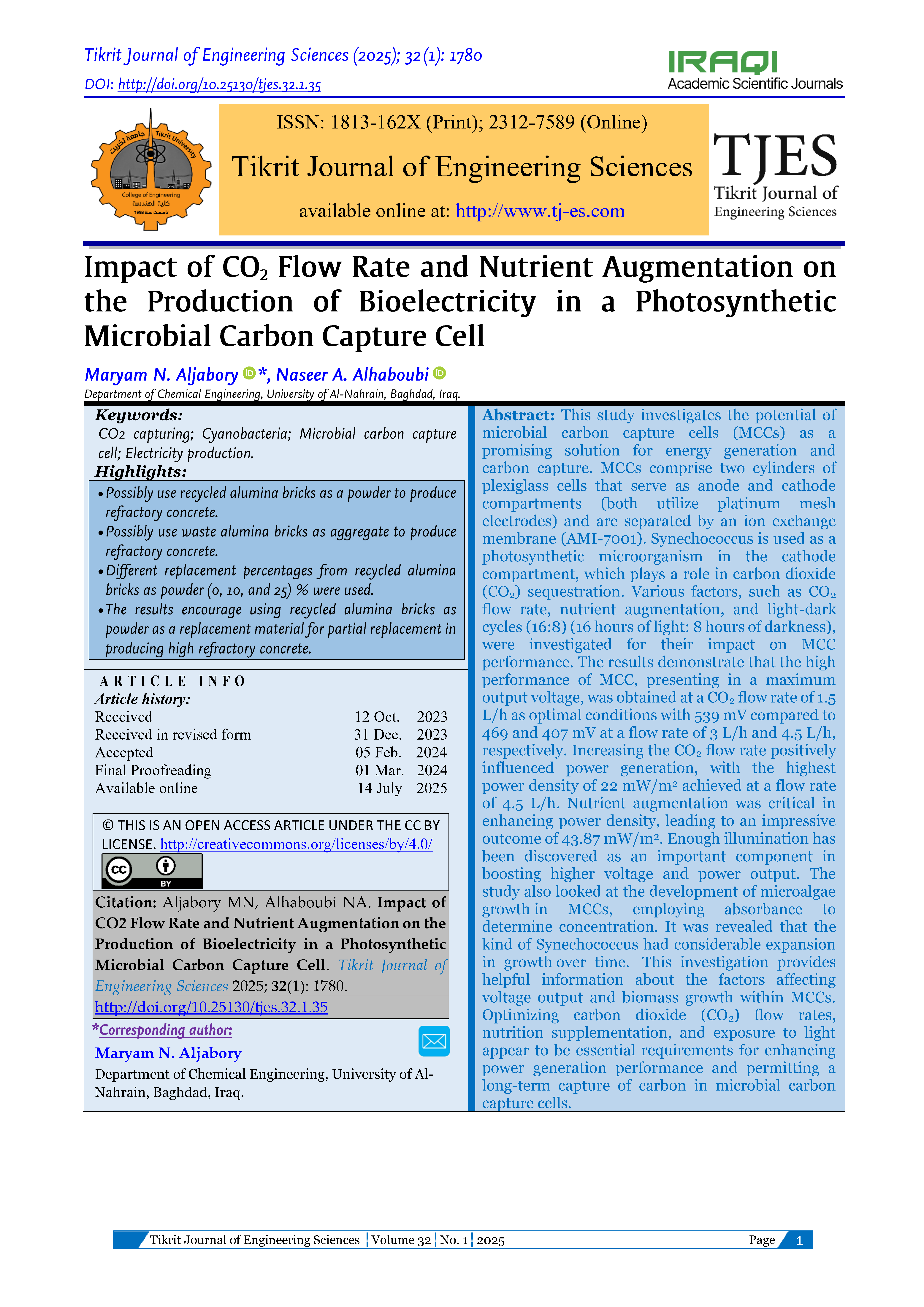Impact of CO2 Flow Rate and Nutrient Augmentation on the Production of Bioelectricity in a Photosynthetic Microbial Carbon Capture Cell
Main Article Content
Abstract
This study investigates the potential of microbial carbon capture cells (MCCs) as a promising solution for energy generation and carbon capture. MCCs comprise two cylinders of plexiglass cells that serve as anode and cathode compartments (both utilize platinum mesh electrodes) and are separated by an ion exchange membrane (AMI-7001). Synechococcus is used as a photosynthetic microorganism in the cathode compartment, which plays a role in carbon dioxide (CO2) sequestration. Various factors, such as CO2 flow rate, nutrient augmentation, and light-dark cycles (16:8) (16 hours of light: 8 hours of darkness), were investigated for their impact on MCC performance. The results demonstrate that the high performance of MCC, presenting in a maximum output voltage, was obtained at a CO2 flow rate of 1.5 L/h as optimal conditions with 539 mV compared to 469 and 407 mV at a flow rate of 3 L/h and 4.5 L/h, respectively. Increasing the CO2 flow rate positively influenced power generation, with the highest power density of 22 mW/m2 achieved at a flow rate of 4.5 L/h. Nutrient augmentation was critical in enhancing power density, leading to an impressive outcome of 43.87 mW/m2. Enough illumination has been discovered as an important component in boosting higher voltage and power output. The study also looked at the development of microalgae growth in MCCs, employing absorbance to determine concentration. It was revealed that the kind of Synechococcus had considerable expansion in growth over time. This investigation provides helpful information about the factors affecting voltage output and biomass growth within MCCs. Optimizing carbon dioxide (CO2) flow rates, nutrition supplementation, and exposure to light appear to be essential requirements for enhancing power generation performance and permitting a long-term capture of carbon in microbial carbon capture cells.
Article Details
Section

This work is licensed under a Creative Commons Attribution 4.0 International License.
THIS IS AN OPEN ACCESS ARTICLE UNDER THE CC BY LICENSE http://creativecommons.org/licenses/by/4.0/
References
Upendar G, Singh S, Chakrabarty J, Chandra Ghanta K, Dutta S, Dutta A. Sequestration of Carbon Dioxide and Production of Biomolecules Using Cyanobacteria. Journal of Environmental Management 2018; 218:234-244.
Wang X, Feng Y, Liu J, Lee H, Li C, Li N, Ren N. Sequestration of CO2 Discharged from Anode by Algal Cathode in Microbial Carbon Capture Cells (MCCs). Biosensors and Bioelectronics 2010; 25(12):2639-2643.
González López CV, Acién Fernández FG, Fernández Sevilla JM, Sánchez Fernández JF, Cerón García MC, Molina Grima E. Utilization of the Cyanobacteria Anabaena sp. ATCC 33047 in CO2 Removal Processes. Bioresource Technology 2009; 100(23):5904-5910.
Das S, Das S, Das I, Ghangrekar MM. Application of Bioelectrochemical Systems for Carbon Dioxide Sequestration and Concomitant Valuable Recovery: A Review. Materials Science for Energy Technologies 2019; 2(3):687-696.
Chen X, Luo J, Qi B, Cao W, Wan Y. NOM Fouling Behavior During Ultrafiltration: Effect of Membrane Hydrophilicity. Journal of Water Process Engineering 2015; 7:1-10.
Hu X, Zhou J, Liu B. Effect of Algal Species and Light Intensity on the Performance of an Air-Lift-Type Microbial Carbon Capture Cell with an Algae-Assisted Cathode. RSC Advances 2016; 6(30):25094-25100.
Zhao L, Deng J, Hou H, Li J, Yang Y. Investigation of PAH and Oil Degradation Along with Electricity Generation in Soil Using an Enhanced Plant-Microbial Fuel Cell. Journal of Cleaner Production 2019; 221:678-683.
Pandit S, Nayak BK, Das D. Microbial Carbon Capture Cell Using Cyanobacteria for Simultaneous Power Generation, Carbon Dioxide Sequestration and Wastewater Treatment. Bioresource Technology 2012; 107:97-102.
Al Gizi A, Radhi S, Mthbob Y. Novel Technical Design of an Early Protection System for an Electronic Fuel Injection System. 2nd International Multi-Disciplinary Conference Theme: Integrated Sciences and Technologies 2022.
Varanasi JL, Prasad S, Singh H, Das D. Improvement of Bioelectricity Generation and Microalgal Productivity with Concomitant Wastewater Treatment in Flat-Plate Microbial Carbon Capture Cell. Fuel 2020; 263:116696.
Tang D, Han W, Li P, Miao X, Zhong J. CO2 Biofixation and Fatty Acid Composition of Scenedesmus obliquus and Chlorella pyrenoidosa in Response to Different CO2 Levels. Bioresource Technology 2011; 102(3):3071-3076.
Fornero JJ, Rosenbaum M, Cotta MA, Angenent LT. Carbon Dioxide Addition to Microbial Fuel Cell Cathodes Maintains Sustainable Catholyte pH and Improves Anolyte pH, Alkalinity, and Conductivity. Environmental Science and Technology 2010; 44(7):2728-2734.
Nam JY, Kim HW, Lim KH, Shin HS. Effects of Organic Loading Rates on the Continuous Electricity Generation from Fermented Wastewater Using a Single-Chamber Microbial Fuel Cell. Bioresource Technology 2010; 101(1):S33-S37.
Liu WF, Cheng SA. Microbial Fuel Cells for Energy Production from Wastewaters: The Way Toward Practical Application. Journal of Zhejiang University: Science A 2014; 15(11):841-861.
González Del Campo A, Cañizares P, Rodrigo MA, Fernández FJ, Lobato J. Microbial Fuel Cell with an Algae-Assisted Cathode: A Preliminary Assessment. Journal of Power Sources 2013; 242:638-645.





